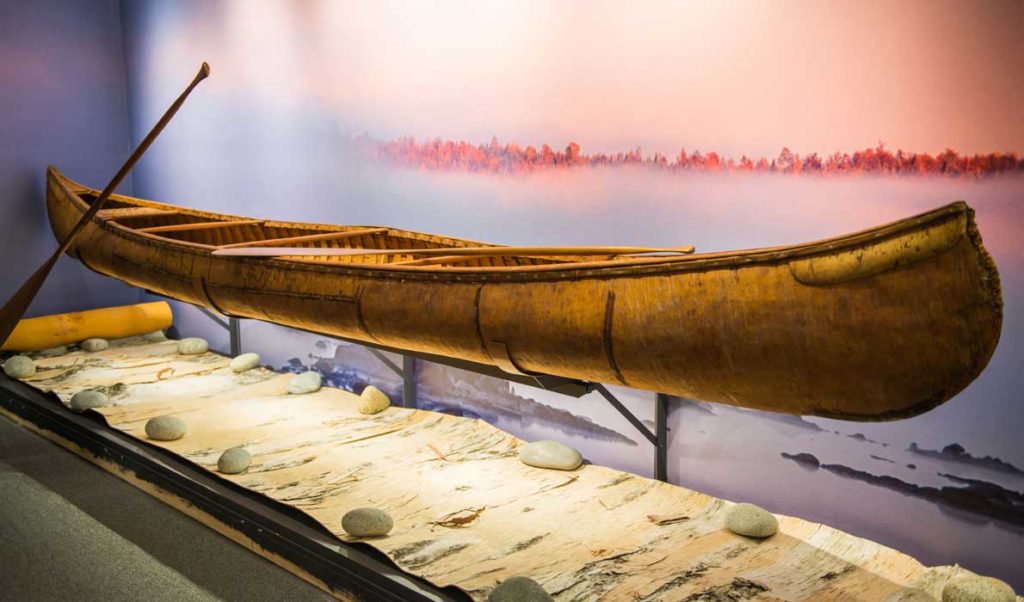The full-sized, birchbark canoe on display at the Peabody Museum in Cambridge, Mass. is both rare and old. Purchased from Penobscot Indian Francis Sebattis in 1912, it was most likely used to guide sportsmen along Maine’s waterways.
These canoes once were ubiquitous in Maine, and they were an integral part of the culture of the Penobscot Nation, according to Irene Castle McLaughlin, a curator for the Peabody, a Harvard University museum. The skillset of canoe-building was handed down from generation to generation.
“In the old days, all the Penobscot men knew how to build canoes,” McLaughlin said.
But somewhere around the time this canoe was purchased from Sebattis, that chain of knowledge was broken, according to Steve Cayard, a traditional canoe-building enthusiast in Maine. For several generations afterwards, there were no birchbark canoes built by Native Americans and First Nation people in New England and the Canadian Maritime provinces. Fortunately, that boatbuilding knowledge had been preserved in museums in North America and the U.K.
“I’ve been to quite a few museums. That’s where I get a lot of information. In fact, it’s my primary source,” Cayard said.
Too often, preservation is a one-way street, where knowledge and heritage is stored in a museum, not to be used by the general public again. That’s not the case here, as birchbark canoe making is experiencing a mini-revival.
In the last 20 years, there have been a handful of these canoes made among the Penobscot and Maliseet tribes in Maine and New Brunswick. Meanwhile, a number of European museums are in the process of returning traditional birchbark canoes to tribes in the northeast of North American, said McLaughlin. And if attendance at the Peabody exhibit is any indication, there may soon be more birchbark canoe enthusiasts who will take up boatbuilding.
“People love the canoes. They are fascinated by the canoes,” said McLaughlin.
A lot of the momentum of this revival can be traced back to Cayard, a former homesteader in Maine with no blood ties to Native American tribes. After building his first birchbark canoe in 1991, Cayard has been conducting canoe-building workshops within Penobscot and Maliseet communities. He is quick to deflect any talk that he is the only catalyst of this revival, though, saying the tribes have taken the initiative to maintain their cultural heritage, and he was invited to help.
“It’s been my pleasure and my honor to do that,” he said.
Launching a birchbark canoe can be a dramatic event for tribal communities. Barry Dana, a former Penobscot chief, organized a canoe-building workshop in his community before meeting Cayard. (The two have worked together, off and on, for years since that first project.) At the time of the launch of the first vessel, an elder told Dana that there probably hadn’t been a canoe like that built in the community for some 60 years.
He ranks canoe-making as the second-most important part of the Penobscot culture, behind only the Penobscot language.
“There is no feeling like making a canoe and putting it in the water and taking it for a spin,” Dana said.
Enthusiasm around birchbark canoe building has given hope to some in the Northeastern tribes who believe traditional ways can be handed down to the next generation. Darrell Paul has been working with Cayard to bring boatbuilding workshops to the Woodstock Band in New Brunswick. A recent canoe-building workshop sparked interest from many tribespeople, and even some tourists.
“Right now, I have a son who is in the process of building one, as we speak,” Paul said.
The Penobscot canoe exhibit will be on display at the Peabody Museum in Harvard until April 2016.
For more information, go to https://www.peabody.harvard.edu/node/938.





